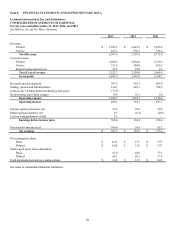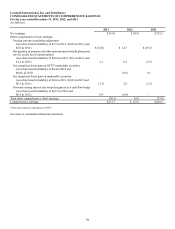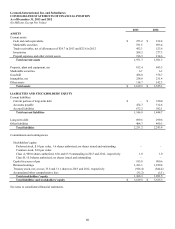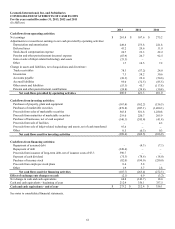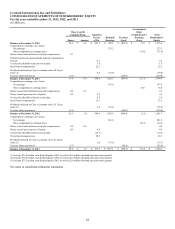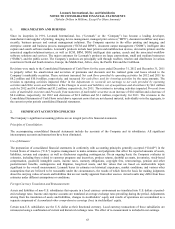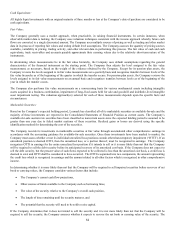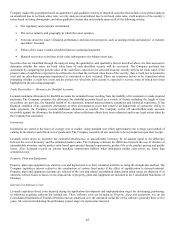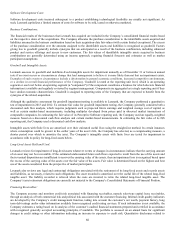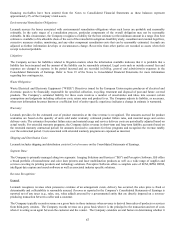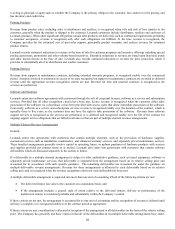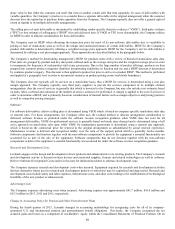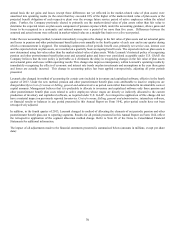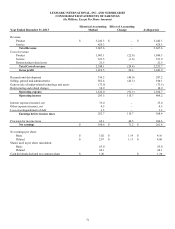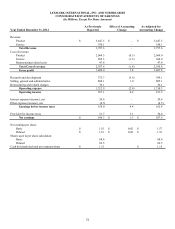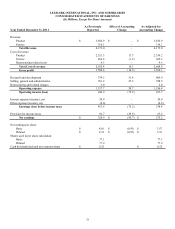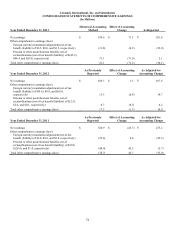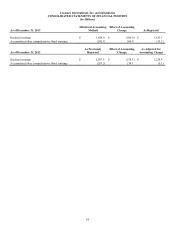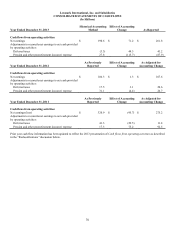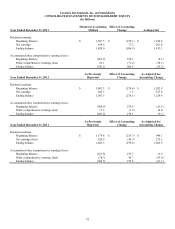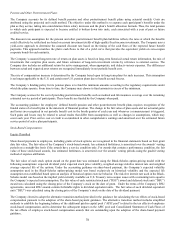Lexmark 2013 Annual Report Download - page 72
Download and view the complete annual report
Please find page 72 of the 2013 Lexmark annual report below. You can navigate through the pages in the report by either clicking on the pages listed below, or by using the keyword search tool below to find specific information within the annual report.
68
is acting as principal or agent such as whether the Company is the primary obligor to the customer, has control over the pricing, and
has inventory and credit risks.
Printing Products
Revenue from product sales, including sales to distributors and resellers, is recognized when title and risk of loss transfer to the
customer, generally when the product is shipped to the customer. Lexmark customers include distributors, resellers and end-users of
Lexmark products. When other significant obligations remain after products are delivered, such as contractual requirements pertaining
to customer acceptance, revenue is recognized only after such obligations are fulfilled. At the time revenue is recognized, the
Company provides for the estimated cost of post-sales support, principally product warranty, and reduces revenue for estimated
product returns.
Lexmark records estimated reductions to revenue at the time of sale for customer programs and incentive offerings including special
pricing agreements, promotions and other volume-based incentives. Estimated reductions in revenue are based upon historical trends
and other known factors at the time of sale. Lexmark also records estimated reductions to revenue for price protection, which it
provides to substantially all of its distributors and reseller customers.
Printing Services
Revenue from support or maintenance contracts, including extended warranty programs, is recognized ratably over the contractual
period. Amounts invoiced to customers in excess of revenue recognized on support or maintenance contracts are recorded as deferred
revenue until the appropriate revenue recognition criteria are met. Revenue for time and material contracts is recognized as the
services are performed.
Software and Solutions
Lexmark enters into software agreements with customers through the sale of perpetual licenses, software as a service and subscription
services. Provided that all other recognition criteria have been met, license revenue is recognized when the customer either takes
possession of the software via a download, or has been provided with access codes that allow immediate possession of the software.
Conversely, software as a service and subscription services revenue is recognized ratably over the duration of the contract, which is
typically three to five years, as the customer does not have the right to take possession of the software. Revenue from software
support services is recognized as the services are performed, or is deferred and recognized ratably over the life of the contract for
ongoing support service obligations that are billed in advance or that are part of multiple element revenue arrangements.
Multiple Element Revenue Arrangements
General:
Lexmark enters into agreements with customers that contain multiple elements, such as the provisions of hardware, supplies,
customized services such as installation, maintenance, and enhanced warranty services, and separately priced maintenance services.
These bundled arrangements generally involve capital or operating leases, or upfront purchases of hardware products with services
and supplies provided per contract terms or as needed. Lexmark also enters into agreements with customers that contain software
deliverables which are discussed separately in the section to follow.
If a deliverable in a multiple element arrangement is subject to other authoritative guidance, such as leased equipment, software or
separately priced maintenance services, that deliverable is separated from the arrangement based on its relative selling price and
accounted for in accordance with such specific guidance. The remaining deliverables are accounted for under the guidance on
multiple-deliverable revenue arrangements. Revenue for these arrangements is allocated to each deliverable based on its relative
selling price and is recognized when the revenue recognition criteria for each deliverable has been met.
A multiple deliverable arrangement is separated into more than one unit of accounting if both of the following criteria are met:
The delivered item(s) has value to the customer on a stand-alone basis; and
If the arrangement includes a general right of return relative to the delivered item(s), delivery or performance of the
undelivered item(s) is considered probable and substantially within the Company’s control.
If these criteria are not met, the arrangement is accounted for as one unit of accounting and the recognition of revenue is deferred until
delivery is complete or is recognized ratably over the contract period as appropriate.
If these criteria are met, consideration is allocated at inception of the arrangement to all deliverables on the basis of the relative selling
price. The Company has generally met these criteria in that all of the deliverables in its multiple deliverable arrangements have stand-
68


